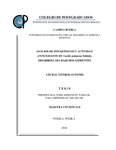Análisis de fitoquímicos y actividad antioxidante de Vanilla pompona Schiede. desarrollada bajo dos ambientes.
Abstract
Las plantas producen fitoquímicos en respuesta ante factores ambientales, y muchos de ellos son los responsables de la actividad antioxidante que sirve para proteger a las plantas del estrés oxidativo. El trabajo tuvo como objetivo analizar los grupos de fitoquímicos y actividad antioxidante en estructuras vegetales y reproductivas de V. pompona y conocer la influencia del ambiente sobre ellos, para potenciar su uso como fuente de compuestos bioactivos. El material vegetal se obtuvo durante el período de floración y se cosecharon frutos en dos localidades (Cazuelas, Papantla, Veracruz y Morelos, Santa Cruz Itundujia, Oaxaca) de México. Los fitoquímicos en hoja, tallo, flor fruto verde y fruto beneficiado de 29, 31 y 36 semanas se analizaron mediante pruebas cualitativas por agentes cromógenos y por cromatografía en capa fina (CCF); la cuantificación de compuestos fenólicos totales (CFT), saponinas totales (SAPT), flavonoides totales (FLAVT) y triterpenos totales (TRIT) se realizó mediante métodos espectrofotométricos; la capacidad antioxidante de analizó frente al radical DPPH/CI50 y por método de ORAC (fracción hidrofílica y fracción lipofílica). Las pruebas realizadas por agentes cromógenos y por CCF, mostraron presencia principalmente de saponinas, terpenos, flavonoides y ácidos fenólico. Por tejido, la hoja tuvo las concentraciones mayores de SAPT y FLAVT, los frutos verdes destacaron por mostrar concentraciones altas de SAPT (3.71 gˑ100 g-1) y las concentraciones mayores de CFT (0.50 gˑ100 g-1) y TRIT (19.79 gˑ100 g-1). Por localidad, Morelos destaco por presentar las concentraciones mayores de FLAVT (0.80 gˑ100 g-1) y Cazuelas tuvo las concentraciones más altas en TRIT (9.30 gˑ100 g-1) y SAPT (3.79 gˑ100 g-1). La capacidad antioxidante mayor se obtuvo en hoja (CI50=2.98 mg•mL-1) y fruto verde de 29 semanas (CI50=4.93 mg•mL-1 MS), frente al radical DPPH. En el ensayo de ORAC, la fracción hidrofílica también mostró los valores mayores en hoja (123,168 a 123,478 µM TE•g-1) seguido de frutos verdes de 29 y 31 semanas. La temperatura media anual y el régimen de humedad del suelo tuvieron efecto en la acumulación de metabolitos (TRIT y SAPT) en la localidad de Cazuelas. _______________ ANALYSIS OF PHYTOCHEMICALS AND ANTIOXIDANT ACTIVITY OF Vanilla pompona Schiede. DEVELOPED UNDER TWO ENVIRONMENTS. ABSTRACT: Plants produce phytochemicals in response to environmental factors, and many of them are responsible for the antioxidant activity used to protect plants from oxidative stress. The study aimed to analyze groups of phytochemicals and antioxidant activity. The study aimed to analyze groups of phytochemicals and antioxidant activity in plant and reproductive structures of Vanilla pompona Schiede and knowing the influence of environment on them, to enhance their use as a source of bioactive compounds. The plant material was obtained during the flowering period and fruits were harvested in two localities (Cazuelas, Papantla, Veracruz and Morelos, Santa Cruz Itundujia, Oaxaca) of Mexico. The phytochemicals in leaf, stem, flower, green fruit and cured fruit of 29, 31 and 36 weeks were analyzed by qualitative tests by chromogenic agents and by thin layer chromatography (TLC). The quantification of total phenolic compounds (CFT), total saponins (SAPT), total flavonoids (FLAVT) and total triterpenes (TRIT) was performed by spectrophotometric methods; the antioxidant capacity was analyzed against the radical DPPH/IC50 and by the ORAC method (hydrophilic fraction and lipophilic fraction). Tests by chromogenic agents and TLC showed the presence primarily of saponins, terpenes, flavonoids and phenolic acids. By tissue, the leaf had the highest concentrations of SAPT and FLAVT, the green fruits stood out for showing high concentrations of SAPT (3.71 g•100 g-1) and the highest concentrations of CFT (0.50 gˑ100 g-1) and TRIT (19.79 gˑ100 g-1). By location, Morelos stood out for presenting the highest concentrations of FLAVT (0.80 gˑ100 g-1) and Cazuelas had the highest concentrations in TRIT (9.30 gˑ100 g-1) and SAPT (3.79 gˑ100 g-1). The highest antioxidant capacity was obtained sheet (CI50 = 2.98 mg•mL-1) and green fruit 29 weeks (CI50 = 4.93 mgˑmL-1), against DPPH radical. In the ORAC assay, the hydrophilic fraction also showed the highest values in leaf (123,168 to 123,478 μM TE•g-1) followed by green fruits of 29 and 31 weeks. The mean annual temperature and soil moisture regime had an effect on the accumulation of metabolites (TRIT and SAPT) in the town of Cazuelas.
Collections
- Tesis MC, MT, MP y DC [398]


